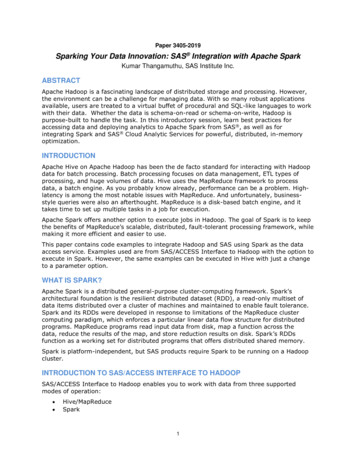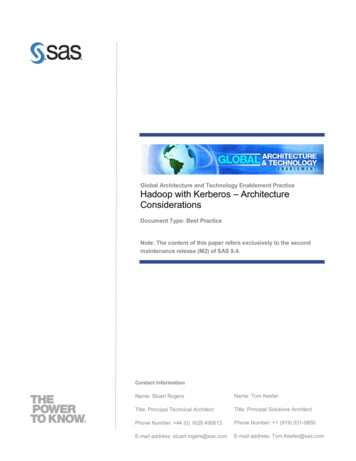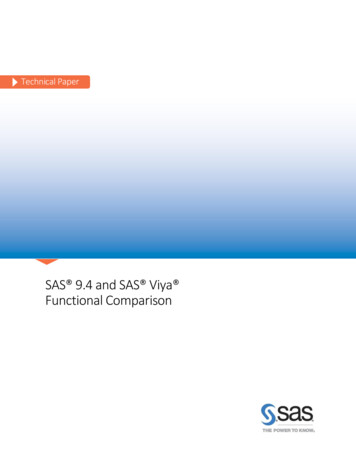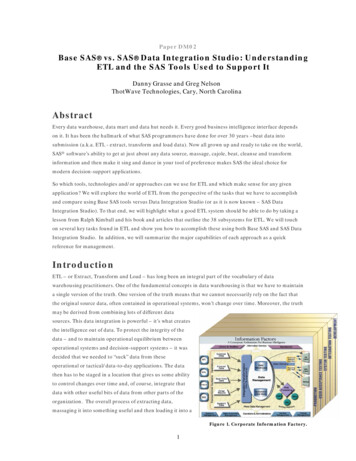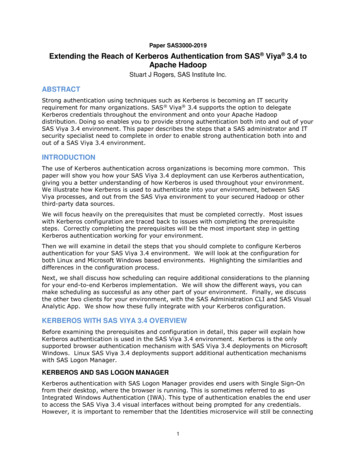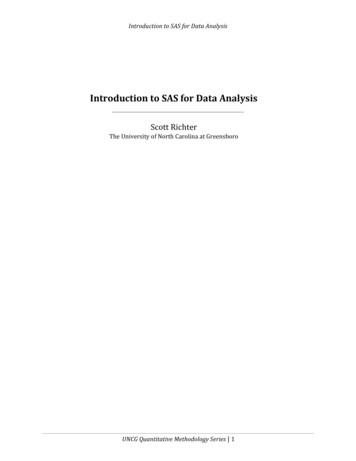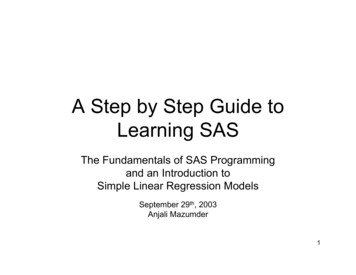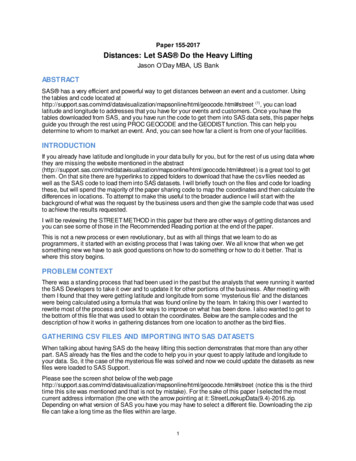
Transcription
Paper 155-2017Distances: Let SAS Do the Heavy LiftingJason O’Day MBA, US BankABSTRACTSAS has a very efficient and powerful way to get distances between an event and a customer. Usingthe tables and code located sonline/html/geocode.html#street (1), you can loadlatitude and longitude to addresses that you have for your events and customers. Once you have thetables downloaded from SAS, and you have run the code to get them into SAS data sets, this paper helpsguide you through the rest using PROC GEOCODE and the GEODIST function. This can help youdetermine to whom to market an event. And, you can see how far a client is from one of your facilities.INTRODUCTIONIf you already have latitude and longitude in your data bully for you, but for the rest of us using data wherethey are missing the website mentioned in the ion/mapsonline/html/geocode.html#street ) is a great tool to getthem. On that site there are hyperlinks to zipped folders to download that have the csv files needed aswell as the SAS code to load them into SAS datasets. I will briefly touch on the files and code for loadingthese, but will spend the majority of the paper sharing code to map the coordinates and then calculate thedifferences in locations. To attempt to make this useful to the broader audience I will start with thebackground of what was the request by the business users and then give the sample code that was usedto achieve the results requested.I will be reviewing the STREET METHOD in this paper but there are other ways of getting distances andyou can see some of those in the Recommended Reading portion at the end of the paper.This is not a new process or even revolutionary, but as with all things that we learn to do asprogrammers, it started with an existing process that I was taking over. We all know that when we getsomething new we have to ask good questions on how to do something or how to do it better. That iswhere this story begins.PROBLEM CONTEXTThere was a standing process that had been used in the past but the analysts that were running it wantedthe SAS Developers to take it over and to update it for other portions of the business. After meeting withthem I found that they were getting latitude and longitude from some ‘mysterious file’ and the distanceswere being calculated using a formula that was found online by the team. In taking this over I wanted torewrite most of the process and look for ways to improve on what has been done. I also wanted to get tothe bottom of this file that was used to obtain the coordinates. Below are the sample codes and thedescription of how it works in gathering distances from one location to another as the bird flies.GATHERING CSV FILES AND IMPORTING INTO SAS DATASETSWhen talking about having SAS do the heavy lifting this section demonstrates that more than any otherpart. SAS already has the files and the code to help you in your quest to apply latitude and longitude toyour data. So, it the case of the mysterious file was solved and now we could update the datasets as newfiles were loaded to SAS Support.Please see the screen shot below of the web apsonline/html/geocode.html#street (notice this is the thirdtime this site was mentioned and that is not by mistake). For the sake of this paper I selected the mostcurrent address information (the one with the arrow pointing at it: StreetLookupData(9.4)-2016.zip.Depending on what version of SAS you have you may have to select a different file. Downloading the zipfile can take a long time as the files within are large.1
The code in the zip folder has instructions for updating it, so that you can put the path for the location ofthe datasets and the location of the csv files to be loaded:Once you make these updates to the code and you have the csv files (TIGER files) in a single directoryyou can run the code. In the case of this paper we have saved the SAS dataset, USM.sas7bdat, to alibrary named SASDATA.PROC GEOCODE TO ASSIGN LATITUDE AND LONGITUDEOnce the code has completed running above and the dataset USM is created in a permanent location(sasdata in this case), we can start to assign the latitude and longitude to the observations in the data. In2
the code below you can see that we need to assign the METHOD and the variables that follow in thePROC GEOCODE process.The fields: ADR 1, STATE, CTY and ZIP CD are from the dataset MemberAddress1, which is the inputtable that we need to match with the USM table in order to get the latitude and longitude variables.PROC GEOCODE DATA WORK.MemberAddress1 /* Input table that needs Coordinates table */OUT WORK.mbrs geo/* Output table that needs Coordinates table */METHOD street/* METHOD Type (street in our case) */LOOKUPSTREET sasdata.usm/* SAS Address lookup table */ADDRESSVAR adr 1/* Address variable in input data set */ADDRESSSTATEVAR state/* State variable in input data set */ADDRESSCITYVAR cty/* City variable in input data set */ADDRESSZIPVAR zip cd/* Zip Code variable in input data set */;RUN;You can see that field ‘Y’ is latitude and ‘X’ is longitude. Other fields that we can use are ‘ MATCHED ’and ‘ SCORE ’. MATCHED will tell you what field it was matched on whether it was ADDRESS, ZIP orCITY. ‘ SCORE ’ gives a numeric value of how well it matched from USM to your dataset, the higher thebetter. We do not use SCORE to filter in this process but I have seen other instances wheredevelopers do filter on it. For more information on these fields and how you can use them see theRecommended Reading section.PROC SQL;CREATE TABLE WORK.mbrs geo1 ASSELECT DISTINCTyAS lat,xAS lon, matched, score,person id,stateFROM WORK.mbrs geoORDER BY person id;QUIT;Below is the same code as above but for the data we need to merge later in order to get the distancesbetween the members and the event locations.PROC GEOCODE DATA WORK.unq envt location /* Input table that needs Coordinates table */OUT WORK.event geo/* Output table that needs Coordinates table */METHOD street/* METHOD Type (street in our case) */LOOKUPSTREET sasdata.usm/* SAS Address lookup table */ADDRESSVAR address/* Address variable in input data set */ADDRESSSTATEVAR state/* State variable in input data set */ADDRESSCITYVAR city/* City variable in input data set */ADDRESSZIPVAR zip cd/* Zip Code variable in input data set */;RUN;PROC SQL;CREATE TABLE WORK.event geo1 ASSELECT DISTINCTyAS lat,xAS lon3
, matched, score,submarket,address,city,state,zip cdFROM WORK.event geoWHERE UPCASE( matched ) 'NONE' /*Keeping only where there is a Match*/ORDER BY submarket;QUIT;USING THE GEODIST FUNCTION RATHER THAN CALCULATING THE DISTANCESWITH SINE AND COSINEOnce we have the latitude and longitude we can begin to put the two datasets together and calculate thedistances. When I met with the business to go over their code, they had used the calculation below. Icould follow it but was looking for a better way. I researched the calculation and found it in a paper byMike Zdeb, “Driving Distances and Times Using SAS and Google Maps” and is called the Haversineformula:d3 3949.99 * arcos(sin(lat1) * sin(lat2) cos(lat1) * cos(lat2) *cos(long2 - long1)).This is one way to do it but as I researched I found that the function GEODIST can be used to calculatethe distance between two points in kilometers, miles, degrees and radians. This seemed like a better wayfor me as I prefer a universal way to code and if new requests for change come from the business andthey want to calculate in kilometers instead of miles there are very small updates to the code that isneeded. I prefer to make my life as easy as possible when developing code.If we look at the structure of the function it is very simple:GEODIST(latitude-1, longitude-1, latitude-2, longitude-2 ,options ) (3)The options are either ‘K’ for kilometers, ‘M’ for miles, ‘D’ for degrees or ‘R’ for radians.In the code below we are joining the tables and calculating the distances in miles and are only keepingthe data were the distance is less than 10 miles and it is not null.PROC SQL;CREATE TABLE WORK.mbr evnt geocoding ASSELECTA.*,E.submarket,E.latAS event lat,E.lonAS event lon,E.state,GEODIST(A.lat, A.lon, E.lat, E.lon, 'M') AS distancetoevent/* M is used for miles in our case */FROM WORK.mbrs geo1 AS aLEFT JOIN WORK.event geo1 AS e ON A.state E.stateWHERE CALCULATED distancetoevent 10AND CALCULATED distancetoevent .ORDER BY A.person id;QUIT;4
FILTER THE DATA BASED ON THE MAXIMUM DISTANCE FOR MARKETINGPURPOSESFinally, the business requested that we develop the code to flag the members that were within a certaindistance to specific submarkets for the events. In the code below we took those parameters and appliedthem to the submarkets: ‘MINNEAPOLIS’, ‘ST. PAUL’, and ‘RICHFIELD’. We cleaned up the data byremoving duplicates and created a finished dataset to send to the marketing team. They could then puttogether the mailing lists for the campaigns.DATA WORK.mbr evnt geocoding 2;SET WORK.mbr evnt geocoding;IF UPCASE(submarket) 'MINNEAPOLIS'AND DistanceToEvent 5.5 THEN evnt within 'Y';ELSE IF UPCASE(submarket) 'ST. PAUL'AND DistanceToEvent 6.0 THEN evnt within 'Y';ELSE IF UPCASE(submarket) 'RICHFIELD'AND DistanceToEvent 7.5 THEN evnt within 'Y';ELSE evnt within 'N';RUN;PROC SORT DATA WORK.mbr evnt geocoding 2;BY distancetoevent;RUN;PROC SORT DATA WORK.mbr evnt geocoding 2OUT WORK.mbr evnt geocoding fnl NODUPKEY;BY person id;RUN;PROC SQL;CREATE TABLE output.radius check ASSELECT DISTINCTA.peron id,CASE WHEN C.evnt within 'Y' THEN 'Y' ELSE 'N' END AS event indFROM WORK.mbrs geo1 AS aLEFT JOIN WORK.mbr evnt geocoding fnl AS c ON A.ucps id C.ucps id;QUIT;CONCLUSIONIn summary, this paper can really be broken down to a few components that will make your life easier asfar as gathering the coordinates for locations and then calculating those differences using SAS. It i s madeeasy because SAS first gives you the latitude and longitude files as well as the code to load them to yourenvironment. Second, SAS gives you the power of PROC GEOCODE which we have barely scratchedthe surface on in this paper. If you want more information on this procedure I suggest reading a few of theresources in the Recommended Reading portion below. Finally, SAS gives the ease of calculating thedistances using the GEODIST function. You can try gathering the coordinates yourself and even usingcomplicated calculations to get the distances, but wouldn’t you prefer to have SAS do the heavy lifting?REFERENCES1. “SAS Maps Online.” SAS Support. mapsonline/html/geocode.html#street2. Zdeb, Mike. “Driving Distances and Times Using SAS and Google Maps” SAS Global Forum2010. s10/050-2010.pdf5
3. “SAS Support 3113162.htmACKNOWLEDGMENTSThank you to Kirk Paul Lafler for proof reading my paper as well as my presentation. That is a huge helpfor a first time presenter and I really appreciate it.RECOMMENDED READING Massengill, Darrell and Odom, Ed. 2013 “PROC GEOCODE: Finding Locations Outside the U.S.”SAS Global Forum 2013. 013.pdf Massengill, Darrell and Odom, Ed. 2013 “PROC GEOCODE: Now with Street-Level Geocoding.” SASGlobal Forum 2010. s10/332-2010.pdfCONTACT INFORMATIONYour comments and questions are valued and encouraged. Contact the author at:Jason O’Day MBAJason.oday@usbank.com6
3 the code below you can see that we need to assign the METHOD and the variables that follow in the PROC GEOCODE process. The fields: ADR_1, STATE, CTY and ZIP_CD are from the dataset MemberAddress1, which is the input

